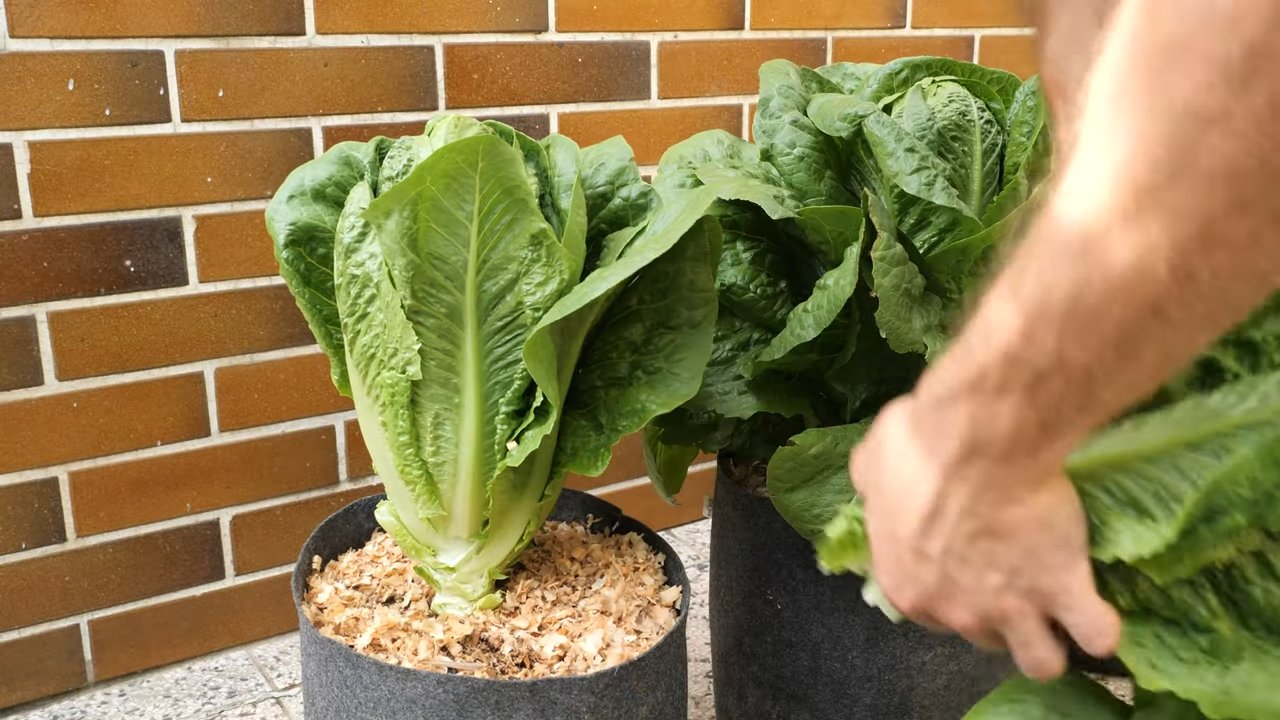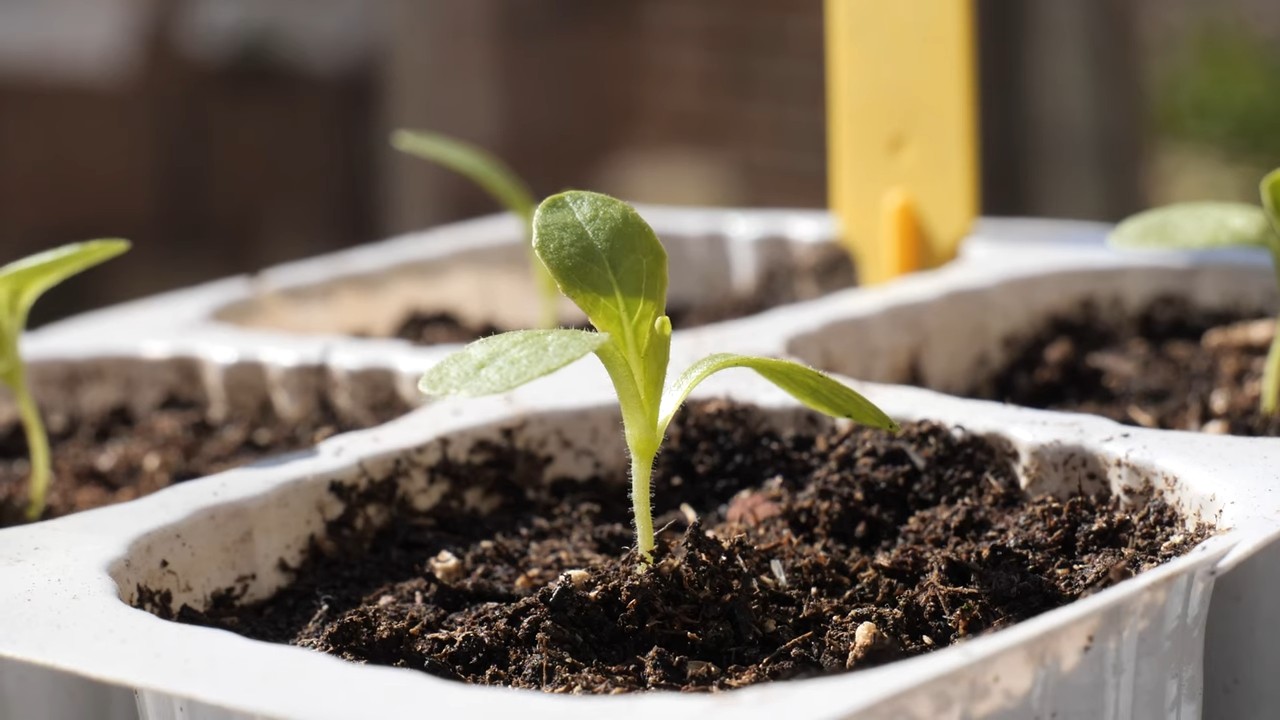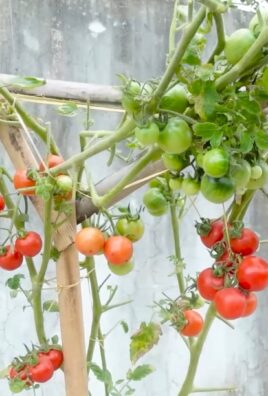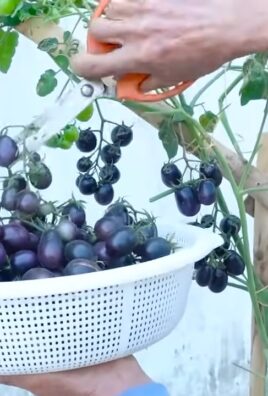Grow Romaine Lettuce at Home, and you’ll unlock a world of fresh, crisp salads right at your fingertips! Forget those wilted, overpriced heads at the grocery store. Imagine stepping into your backyard or onto your balcony and harvesting vibrant, healthy Romaine whenever you crave a Caesar salad or a crunchy wrap.
For centuries, cultivating lettuce has been a cornerstone of home gardens, dating back to ancient Egypt where it was initially grown for its seeds and oil. Over time, its leafy greens became prized for their refreshing taste and nutritional value. Today, the tradition continues, and with these simple DIY tricks, you can easily join the ranks of home gardeners enjoying the fruits (or rather, vegetables!) of their labor.
Why should you learn these DIY hacks? Because growing your own Romaine lettuce isn’t just about saving money; it’s about knowing exactly where your food comes from. You control the pesticides, the fertilizers, and the overall quality. Plus, there’s something incredibly satisfying about nurturing a plant from seed to harvest. I’m excited to share these easy-to-follow tips that will have you enjoying homegrown Romaine lettuce in no time. Let’s get started and grow Romaine Lettuce at Home!

Grow Your Own Delicious Romaine Lettuce: A Beginner’s Guide
Hey there, fellow garden enthusiasts! Are you ready to ditch the grocery store lettuce and enjoy fresh, crisp romaine right from your own backyard (or balcony!)? Growing romaine lettuce at home is surprisingly easy, even if you don’t have a green thumb. I’m going to walk you through everything you need to know, from seed to salad. Let’s get started!
What You’ll Need
Before we dive into the nitty-gritty, let’s gather our supplies. Here’s a checklist of everything you’ll need to successfully grow romaine lettuce:
* Romaine Lettuce Seeds: Choose your favorite variety! There are tons of options, from classic green romaine to red romaine.
* Seed Starting Trays or Small Pots: These will be used to germinate the seeds.
* Seed Starting Mix: This is a light, airy soil mix specifically designed for seedlings.
* Watering Can or Spray Bottle: For gentle watering.
* Grow Lights (Optional): If you’re starting seeds indoors, grow lights can help ensure strong, healthy seedlings.
* Garden Soil or Potting Mix: For transplanting the seedlings into their final growing location.
* Fertilizer (Optional): A balanced fertilizer can give your lettuce a boost.
* Gardening Gloves: To keep your hands clean.
* Trowel or Small Shovel: For transplanting.
* Slug and Snail Bait (Optional): If you live in an area prone to slugs and snails.
Starting Your Romaine Lettuce Seeds
This is where the magic begins! You can either direct sow your seeds into the garden, but I prefer starting them indoors for a head start, especially if you live in an area with a short growing season.
1. Prepare Your Seed Starting Trays: Fill your seed starting trays or small pots with seed starting mix. Gently pat the soil down to remove any air pockets.
2. Sow the Seeds: Sprinkle a few romaine lettuce seeds on top of the soil in each cell or pot. Romaine lettuce seeds are tiny, so don’t worry about being too precise.
3. Cover the Seeds: Lightly cover the seeds with a thin layer of seed starting mix. They need a little bit of darkness to germinate.
4. Water Gently: Use a watering can or spray bottle to gently moisten the soil. Be careful not to overwater, as this can cause the seeds to rot.
5. Provide Light and Warmth: Place the seed starting trays in a warm location with plenty of light. If you’re using grow lights, position them a few inches above the trays. A temperature of around 60-70°F (15-21°C) is ideal for germination.
6. Keep the Soil Moist: Check the soil daily and water as needed to keep it consistently moist, but not soggy.
7. Wait for Germination: Romaine lettuce seeds typically germinate in 7-14 days. Be patient!
Transplanting Your Romaine Lettuce Seedlings
Once your seedlings have developed a few sets of true leaves (the leaves that look like miniature versions of romaine lettuce leaves), they’re ready to be transplanted into their final growing location.
1. Harden Off the Seedlings: Before transplanting, you’ll need to “harden off” the seedlings. This means gradually exposing them to outdoor conditions to help them adjust to the sun, wind, and temperature changes. Start by placing the trays outdoors in a sheltered location for a few hours each day, gradually increasing the amount of time they spend outside over the course of a week.
2. Prepare the Planting Bed: Choose a location in your garden that receives at least 6 hours of sunlight per day. Romaine lettuce prefers well-drained soil that is rich in organic matter. Amend the soil with compost or other organic matter if needed.
3. Dig Holes: Dig holes that are slightly larger than the root balls of your seedlings. Space the holes about 12 inches apart to allow the lettuce plants plenty of room to grow.
4. Carefully Remove the Seedlings: Gently remove the seedlings from their trays or pots. Be careful not to damage the roots.
5. Transplant the Seedlings: Place the seedlings into the holes and gently backfill with soil. Firm the soil around the base of the plants.
6. Water Thoroughly: Water the transplanted seedlings thoroughly to help them settle in.
Caring for Your Romaine Lettuce Plants
Now that your romaine lettuce plants are in the ground, it’s time to provide them with the care they need to thrive.
1. Water Regularly: Romaine lettuce needs consistent moisture to grow well. Water deeply whenever the top inch of soil feels dry to the touch. Avoid overwatering, as this can lead to root rot.
2. Fertilize (Optional): If you want to give your lettuce a boost, you can fertilize it with a balanced fertilizer every few weeks. Follow the instructions on the fertilizer package.
3. Weed Regularly: Keep the area around your lettuce plants free of weeds. Weeds compete with the lettuce for water and nutrients.
4. Protect from Pests: Keep an eye out for pests such as slugs, snails, and aphids. If you notice any pests, take action to control them. You can use organic pest control methods such as hand-picking, diatomaceous earth, or insecticidal soap.
5. Provide Shade During Hot Weather: Romaine lettuce can bolt (go to seed) in hot weather. If you live in an area with hot summers, provide your lettuce plants with some shade during the hottest part of the day. You can use shade cloth or plant them in a location that receives afternoon shade.
Harvesting Your Romaine Lettuce
The best part! You can start harvesting your romaine lettuce when the heads are about 6-8 inches tall.
1. Harvest Outer Leaves: You can harvest the outer leaves of the lettuce plant as needed, leaving the inner leaves to continue growing. This is known as “cut-and-come-again” harvesting.
2. Harvest the Entire Head: Alternatively, you can harvest the entire head of lettuce by cutting it off at the base with a sharp knife.
3. Wash and Enjoy: Wash the harvested lettuce leaves thoroughly before eating. Enjoy them in salads, sandwiches, or wraps.
Troubleshooting Common Problems
Even with the best care, you might encounter some problems while growing romaine lettuce. Here are a few common issues and how to address them:
* Bolting: Bolting is when the lettuce plant prematurely goes to seed. This is usually caused by hot weather or stress. To prevent bolting, provide shade during hot weather and water regularly.
* Slugs and Snails: Slugs and snails can damage lettuce leaves. You can control them by using slug and snail bait, hand-picking them off the plants, or creating barriers around the plants.
* Aphids: Aphids are small, sap-sucking insects that can weaken lettuce plants. You can control them by spraying the plants with insecticidal soap or releasing beneficial insects such as ladybugs.
* Root Rot: Root rot is a fungal disease that can cause the roots of the lettuce plant to rot. This is usually caused by overwatering. To prevent root rot, make sure the soil is well-drained and avoid overwatering.
Succession Planting for a Continuous Harvest
To enjoy a continuous harvest of romaine lettuce throughout the growing season, consider succession planting. This means planting new seeds every few weeks. This way, you’ll always have a supply of fresh lettuce ready to harvest. I usually start new seeds every 2-3 weeks to keep the salads coming!
Choosing the Right Romaine Variety
There are many different varieties of romaine lettuce to choose from, each with its own unique characteristics. Here are a few popular options:
* ‘Paris Island Cos’: A classic romaine variety with tall, upright heads and crisp, flavorful leaves.
* ‘Little Gem’: A smaller, more compact romaine variety that is perfect for small gardens or containers.
* ‘Red Romaine’: A beautiful romaine variety with reddish-purple leaves.
* ‘Freckles’: A unique romaine variety with speckled leaves.
Experiment with different varieties to find your favorites!
Growing Romaine in Containers
Don’t have a garden? No problem! Romaine lettuce can also be grown successfully in containers. Choose a container that is at least 6 inches deep and wide. Fill the container with a good quality potting mix. Follow the same steps for starting seeds and transplanting as you would for growing romaine in the garden. Be sure to water the container regularly, as containers tend to dry out more quickly than garden soil.
Enjoy Your Homegrown Romaine!
There you have it! Everything you need to know to grow your own delicious romaine lettuce at home. With a little bit of care and attention, you’ll

Conclusion
So, there you have it! Growing your own Romaine lettuce at home is not only achievable but also incredibly rewarding. Forget those wilted, overpriced heads of lettuce at the grocery store. Imagine stepping out into your garden or onto your balcony and harvesting crisp, vibrant Romaine whenever you need it. The difference in taste and texture is truly remarkable – a freshness you simply can’t replicate with store-bought produce.
This DIY trick is a must-try for several reasons. First, it’s incredibly cost-effective. A single packet of Romaine lettuce seeds can yield a bounty of lettuce heads, saving you money in the long run. Second, it’s environmentally friendly. You’re reducing your carbon footprint by eliminating the transportation and packaging associated with commercially grown lettuce. Third, it’s empowering! There’s a unique satisfaction in nurturing a plant from seed to harvest, knowing you’ve provided fresh, healthy food for yourself and your family.
But the benefits don’t stop there. Growing your own Romaine lettuce allows you to control the growing environment, ensuring that your lettuce is free from harmful pesticides and herbicides. You can choose organic seeds and fertilizers, creating a truly healthy and sustainable food source.
Ready to take your Romaine lettuce game to the next level? Consider experimenting with different varieties. ‘Little Gem’ Romaine is perfect for smaller gardens, while ‘Paris Island Cos’ offers a classic, robust flavor. You can also try succession planting, sowing new seeds every few weeks to ensure a continuous harvest throughout the growing season.
Another variation to consider is hydroponic Romaine lettuce growing. This method is perfect for those with limited space or poor soil conditions. Hydroponics allows you to grow lettuce indoors, year-round, with minimal effort.
Don’t be intimidated if you’re a beginner gardener. Growing Romaine lettuce is relatively easy, and with a little patience and attention, you’ll be enjoying fresh salads in no time. Remember to provide your lettuce with plenty of sunlight, well-drained soil, and regular watering. Keep an eye out for pests and diseases, and take action promptly if you notice any problems.
We wholeheartedly encourage you to try this DIY trick and experience the joy of growing your own Romaine lettuce. It’s a simple, sustainable, and satisfying way to add fresh, healthy greens to your diet.
Once you’ve harvested your first head of homegrown Romaine, we’d love to hear about your experience! Share your tips, tricks, and photos in the comments below. Let’s create a community of Romaine lettuce enthusiasts and inspire others to embrace the joys of gardening. What are you waiting for? Get planting!
Frequently Asked Questions (FAQ)
What is the best time of year to plant Romaine lettuce?
The best time to plant Romaine lettuce depends on your climate. In cooler climates, you can start seeds indoors 4-6 weeks before the last expected frost and transplant them outdoors once the soil has warmed up. In warmer climates, you can plant Romaine lettuce in the fall or early spring to avoid the heat of summer. Romaine lettuce prefers temperatures between 60°F and 70°F (15°C and 21°C). If you live in a region with hot summers, consider planting your Romaine lettuce in a partially shaded area to prevent bolting (premature flowering).
How much sunlight does Romaine lettuce need?
Romaine lettuce needs at least 6 hours of sunlight per day to thrive. However, in hotter climates, it can benefit from some afternoon shade to prevent bolting. If you’re growing Romaine lettuce indoors, use grow lights to provide adequate light.
What kind of soil is best for growing Romaine lettuce?
Romaine lettuce prefers well-drained soil that is rich in organic matter. Amend your soil with compost or other organic materials before planting to improve drainage and fertility. The ideal soil pH for Romaine lettuce is between 6.0 and 7.0.
How often should I water Romaine lettuce?
Romaine lettuce needs consistent moisture to grow well. Water your lettuce regularly, especially during hot, dry weather. Aim to keep the soil consistently moist but not waterlogged. Overwatering can lead to root rot, so be sure to provide adequate drainage. A good rule of thumb is to water deeply when the top inch of soil feels dry to the touch.
How do I prevent Romaine lettuce from bolting?
Bolting is a common problem with Romaine lettuce, especially in hot weather. To prevent bolting, choose bolt-resistant varieties, provide shade during the hottest part of the day, and water regularly. You can also mulch around your lettuce plants to help keep the soil cool and moist. Harvesting your lettuce regularly can also help prevent bolting.
What are some common pests and diseases that affect Romaine lettuce?
Some common pests that affect Romaine lettuce include aphids, slugs, and snails. You can control these pests by handpicking them off the plants, using insecticidal soap, or setting traps. Common diseases that affect Romaine lettuce include downy mildew and powdery mildew. To prevent these diseases, provide good air circulation, avoid overhead watering, and use disease-resistant varieties.
How do I harvest Romaine lettuce?
You can harvest Romaine lettuce by cutting the entire head at the base or by harvesting individual leaves as needed. If you harvest individual leaves, start with the outer leaves and work your way towards the center. This will allow the plant to continue producing new leaves. Harvest your lettuce in the morning when the leaves are crisp and cool.
Can I grow Romaine lettuce in containers?
Yes, you can grow Romaine lettuce in containers. Choose a container that is at least 6 inches deep and has drainage holes. Use a well-draining potting mix and water regularly. Place the container in a sunny location that receives at least 6 hours of sunlight per day.
How long does it take for Romaine lettuce to grow?
Romaine lettuce typically takes 65-85 days to mature from seed. However, you can start harvesting individual leaves as soon as they are large enough to eat.
Is homegrown Romaine lettuce more nutritious than store-bought?
Generally, yes. Homegrown Romaine lettuce is often more nutritious than store-bought lettuce because it is harvested at its peak ripeness and consumed shortly thereafter. Store-bought lettuce, on the other hand, may have been harvested days or even weeks before it reaches your plate, resulting in a loss of nutrients. Growing your own Romaine lettuce also allows you to control the growing environment and avoid the use of harmful pesticides and herbicides, further enhancing its nutritional value.





Leave a Comment